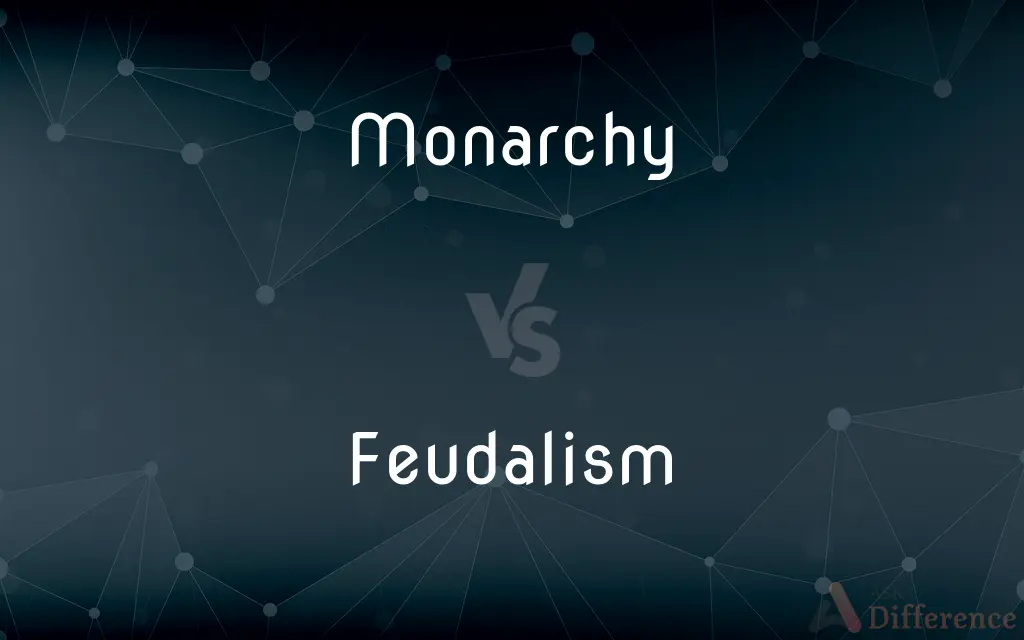Monarchy vs. Feudalism — What's the Difference?
Edited by Tayyaba Rehman — By Maham Liaqat — Updated on March 19, 2024
Monarchy is a form of government with a monarch at the head, while feudalism is a social and economic system that structured society around relationships derived from the holding of land in exchange for service or labor.

Difference Between Monarchy and Feudalism
Table of Contents
ADVERTISEMENT
Key Differences
Monarchy is a political system where a single ruler, a monarch, reigns until death or abdication, with the position often inherited. This system can vary from absolute, where the monarch has complete control, to constitutional, where the monarch's powers are limited by law or a governing body. Feudalism, on the other hand, was a societal structure prevalent in medieval Europe, characterized by a hierarchy of lords and vassals, where land ownership dictated power and peasants worked the land for the nobility in exchange for protection.
While monarchy focuses on the governance aspect, with laws and policies emanating from a singular leadership, feudalism deals more with economic and social organization, emphasizing the relationships between different social classes based on land and service. A monarch could preside over a feudal society, making these systems not mutually exclusive but interlinked in historical contexts.
In a monarchy, succession is typically hereditary, based on bloodlines, which could lead to stability or conflict, depending on the legitimacy and competence of the heirs. Feudalism relied on the loyalty and military support between lords and vassals, with land granted in exchange for service, particularly military protection. This often led to a decentralized power structure, with local lords wielding significant authority over their domains.
Monarchies have adapted over time, with many transitioning to constitutional forms that respect the rule of law and democratic principles, although absolute monarchies still exist. Feudalism, however, has largely disappeared as a system, replaced by modern economic systems and centralized governance, though its legacy can still be seen in aspects of land ownership and social hierarchy.
Both monarchy and feudalism have shaped historical narratives and the development of societies. Monarchies have evolved into modern state systems in many parts of the world, while feudalism's decline paved the way for the rise of nation-states and capitalism, marking significant shifts in how power and resources are distributed and managed.
ADVERTISEMENT
Comparison Chart
Definition
A form of government with a single ruler, a monarch, at the head.
A social and economic system based on land ownership and personal allegiance.
Key Element
The role and power of the monarch.
The relationship between lords and vassals based on land and service.
Focus
Governance and political authority.
Social and economic organization.
Power Structure
Centralized in the monarch, though can be limited by laws or a parliament in constitutional monarchies.
Decentralized, with power distributed among various lords who control land.
Succession
Typically hereditary, passing through bloodlines.
Based on feudal contracts and allegiances, often hereditary among nobility.
Historical Context
Can exist in various forms across different eras and regions.
Predominantly observed in medieval Europe, though similar systems found in other cultures.
Modern Presence
Continues in various forms, including absolute and constitutional monarchies.
Largely obsolete, replaced by modern governance and economic systems.
Compare with Definitions
Monarchy
Can be absolute or constitutional, depending on the monarch's powers.
Saudi Arabia operates as an absolute monarchy.
Feudalism
A medieval European system linking land ownership with nobility and servitude.
Feudalism structured medieval French society.
Monarchy
Monarchs usually inherit their position.
Queen Elizabeth II inherited the throne from her father.
Feudalism
Peasants worked the land for the nobility.
Serfs were bound to the land they farmed for their lord.
Monarchy
Historically, monarchies were common worldwide.
The Pharaohs ruled ancient Egypt as monarchs.
Feudalism
Lords provided protection in exchange for service.
Vassals served their lord in exchange for land.
Monarchy
Monarchies often have a ceremonial role in modern politics.
In Sweden, the monarchy is largely symbolic.
Feudalism
Feudal contracts formalized lord-vassal relationships.
Feudal oaths bound vassals to their lords.
Monarchy
Government by a single ruler, such as a king or queen.
The United Kingdom is a constitutional monarchy.
Feudalism
Declined with the rise of central authority and capitalism.
Feudalism waned as nation-states emerged in Europe.
Monarchy
A monarchy is a form of government in which a person, the monarch, is head of state for life or until abdication. The political legitimacy and authority of the monarch may vary from restricted and largely symbolic (constitutional monarchy), to fully autocratic (absolute monarchy), and can expand across the domains of the executive, legislative, and judicial.
Feudalism
Feudalism, also known as the feudal system, was the combination of the legal, economic, military, and cultural customs that flourished in Medieval Europe between the 9th and 15th centuries. Broadly defined, it was a way of structuring society around relationships that were derived from the holding of land in exchange for service or labor.
Monarchy
Government by a monarch.
Feudalism
A political and economic system of Europe from the 9th to about the 15th century, based on the holding of all land in fief or fee and the resulting relation of lord to vassal and characterized by homage, legal and military service of tenants, and forfeiture.
Monarchy
A state ruled or headed by a monarch.
Feudalism
A political, economic, or social order resembling this medieval system.
Monarchy
A government in which sovereignty is embodied within a single, today usually hereditary head of state (whether as a figurehead or as a powerful ruler).
An absolute monarchy is a monarchy where the monarch is legally the ultimate authority in all temporal matters.
A constitutional monarchy is a monarchy in which the monarch's power is legally constrained, ranging from where minor concessions have been made to appease certain factions to where the monarch is a figurehead with all real power in the hands of a legislative body.
Feudalism
A social system based on personal ownership of resources and personal fealty between a suzerain (lord) and a vassal (subject). Defining characteristics are direct ownership of resources, personal loyalty, and a hierarchical social structure reinforced by religion.
Monarchy
The territory ruled over by a monarch; a kingdom.
Feudalism
The feudal system; a system by which the holding of estates in land is made dependent upon an obligation to render military service to the king or feudal superior; feudal principles and usages.
Monarchy
A form of government where sovereignty is embodied by a single ruler in a state and his high aristocracy representing their separate divided lands within the state and their low aristocracy representing their separate divided fiefs.
Feudalism
The social system that developed in Europe in the 8th C; vassals were protected by lords who they had to serve in war
Monarchy
States based on a system of governance headed by a king or a queen.
Monarchy
A state or government in which the supreme power is lodged in the hands of a monarch.
Monarchy
A system of government in which the chief ruler is a monarch.
In those days he had affected zeal for monarchy.
Monarchy
The territory ruled over by a monarch; a kingdom.
What scourage for perjuryCan this dark monarchy afford false Clarence.
Monarchy
An autocracy governed by a monarch who usually inherits the authority
Common Curiosities
What distinguishes monarchy from feudalism?
Monarchy is a form of government centered on a monarch, while feudalism is a socio-economic system based on land and service.
Is feudalism still present today?
Feudalism as a system has largely been replaced, but its influences can still be seen in modern land and social hierarchies.
What is the legacy of feudalism in today's world?
The legacy of feudalism can be seen in modern property laws, social stratification, and in the cultural identities of regions.
How does power distribution differ in these systems?
Monarchies centralize power in the monarch, while feudalism involves a decentralized power structure among various lords.
How has monarchy adapted to the modern world?
Many monarchies have become constitutional, limiting the monarch's power and integrating democratic principles.
What led to the decline of feudalism?
The rise of central authority, nation-states, and economic changes, such as the advent of capitalism, contributed to feudalism's decline.
Can a monarchy exist within a feudal system?
Yes, historically, monarchies and feudalism often coexisted, with monarchs ruling over a feudal society.
What role do monarchs play in constitutional monarchies?
In constitutional monarchies, monarchs often have a ceremonial role, with governance conducted by elected officials.
How did feudalism affect medieval society?
Feudalism structured society into strict hierarchies, influencing social status, land ownership, and obligations.
How do succession practices differ between these systems?
Monarchies typically have clear hereditary succession, while feudal succession involved complex allegiances and land rights.
Share Your Discovery

Previous Comparison
Sahara vs. Sport
Next Comparison
Boy vs. KnaveAuthor Spotlight
Written by
Maham LiaqatEdited by
Tayyaba RehmanTayyaba Rehman is a distinguished writer, currently serving as a primary contributor to askdifference.com. As a researcher in semantics and etymology, Tayyaba's passion for the complexity of languages and their distinctions has found a perfect home on the platform. Tayyaba delves into the intricacies of language, distinguishing between commonly confused words and phrases, thereby providing clarity for readers worldwide.













































